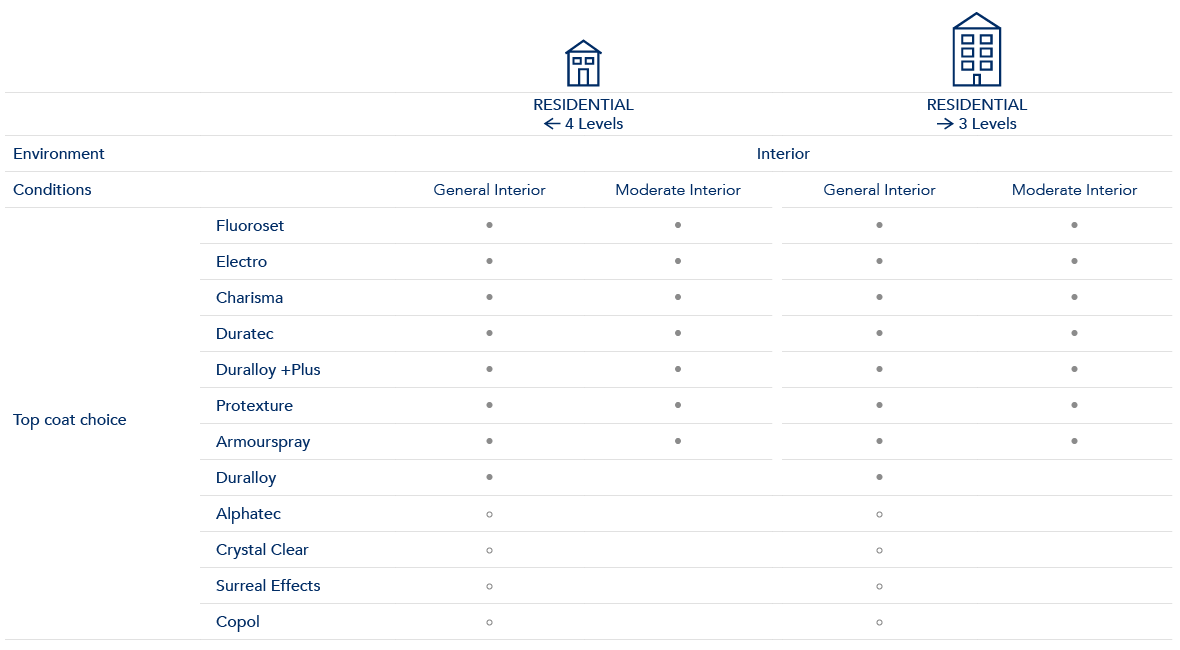
Select your site:
New Zealand
Contact Us

- Architectural
- Industrial
- Colour
- Gallery
- Information
- Why Dulux
- Find an Applicator
- Sign In / Register
Residential projects can range from single dwelling homes through to multi-residential units, apartments, flats, and townhouses. It is important to define your project correctly to ensure the correct product is specified and the performance and warranty is able to be gained for your project.
To help in this process we utilise:
1. The building classifications under the New Zealand Building Code.
2. Industry standards for powder coatings
The following tables detail the NZBC classes, building examples in those classes, and the industry standards that a product should meet to be suitable.
Use this information as a guide to identifying your project and the choice of product that you have, including exterior and interior applications.


• Alumi Shield and Steel Shield warranties are available when applied by a Dulux Accredited Powder Coater to the warranty specification on recommended project types and conditions
○ Non-warrantable
All Dulux powder products are NOT suitable in strongly acidic or caustic environments so pH must be between 5 and 9.
Please refer to ‘Interior environments close to liquids’ for warranty implications where powder coatings may be in close proximity to liquids.
Information for Perforated and Expanded aluminium:
Alumi Shield™ warranties on perforated and expanded aluminium in interior environments are available for the following products and conditions:
a. General – Duralloy, Armourspray, Protexture, Duralloy +Plus, Duratec, Charisma, Electro and Fluoroset (E-Prime base coat not mandatory)
b. Moderate – Armourspray, Protexture, Duralloy +Plus, Duratec, Charisma, Electro and Fluoroset (E-Prime base coat mandatory)
For more information about specifications on perforated or expanded aluminium please click here.
Use the following table which references AS2312.1, SNZTS 3404 and ISO 9223 to identify the environment, conditions and atmospheric corrosivity categories



• Alumi Shield™ and Steel Shield warranties are available when applied by a Dulux Accredited Powder Coater to the warranty specification on recommended project types and conditions
All Dulux powder products are NOT suitable in strongly acidic or caustic environments so the pH must be between 5 and 9.
1. Fluoroset may be suitable in locations <10m from the high tide line e.g. harbours (contact Dulux for advice).
2. Electro, Charisma, Duratec, Duralloy +PLUS, Protexture and Armourspray are only suitable for environments >10m from the high tide line.
3. Duralloy is only suitable for environments >100m from the high tide line.
Please refer to ‘Exterior environments close to liquids other than coastal, river and lake salt water environments’ for warranty implications where powder coatings may be in close proximity to liquids.
Information for Perforated and Expanded aluminium:
Alumi Shield™ warranties on perforated and expanded aluminium in exterior environments are available for the following products and conditions:
a. Mild – Duralloy, Armourspray, Protexture, Duralloy +Plus, Duratec, Charisma, Electro and Fluoroset (E-Prime base coat not mandatory)
b. Severe – Armourspray, Protexture, Duralloy +Plus, Duratec, Charisma, Electro and Fluoroset (E-Prime base coat mandatory)
For more information about specifications on perforated or expanded aluminium please click here.
Use the following table which references AS2312.1, SNZTS 3404 and ISO 9223 to identify the environment, conditions and atmospheric corrosivity categories

1. Geothermal environments greater than 500m of a bore, mud pool, steam vent, or other source with a pH between 5 and 9. For pH outside this consult Dulux.
2. Geothermal hot spots within 500m of a bore, mud pool, steam vent, or other source.
3. All offshore islands including Waiheke Island, Stewart Island, Fraser Island and Pacific islands eg PNG, Fiji, Samoa, Tonga, Tahiti, Noumea
4. The corrosion rates for the first year of exposure for the different corrosivity categories of Aluminium and Carbon (Mild) Steel are determined by the following standards:
5. The corrosion rates for the first year of exposure for the different corrosivity categories of Aluminium are determined by the following standard:
